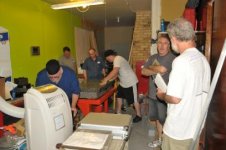If anyone is interested, here's some details on some homemade optical flats made by a friend of mine as a bit of a personal challenge. Lapping glass has an advantage in that the material is transparent and optically reflective enough that the surfaces can be tested with simple home made optical apparatus. Forrest: the initial rough lapping is done with cast iron tools up to a certain point, then three discs are lapped against each other in a specific sequence of the disc A, B & C against each other with discs spending equal time on top and on the bottom with final optical polishing done with cerium oxide or red iron oxide. A polishing tool coated with pitch allows the abrasive charged polishing tool to be pressed against the optical surface so the the soft pitch will conform to the shape of the optical surface.
Testing of the surfaces involved letting the glass discs cool for several hours in the testing equipment after the last bit of lapping and then testing early in the morning to avoid vibrations cause by the street traffic going past.
So optical flats are within the reach of the amateur but there's a prodigious amount of patience and effort involved. In the photo below you can see two of the three discs placed one on top of the other with a tiny nylon shim at one side and illuminated with a sodium discharge lamp: the interference pattern formed accurately shows the combined error of both flats taken together of about one wavelength (the width of a dark and bright line in the image) down the bottom of the discs. The sodium vapour lamp wavelength is 589.3 nanometres or 0.0000232 thou so the combined error of the two optical flats is 0.000000232" (my math may be wrong there) at worst. Each flat's error can be deduced by comparing the interference fringes formed against the other two flats and counting the fringe pattern.
Lapping is more suited to making accurate shapes due to long term averaging of the lapping strokes and works best with simple geometric shapes like flats, spheres, sections of toroids (doughnuts) and cylinders. The hardest of all shapes to lap is a flat due to curves forming when the lapping tool overhangs the object being lapped and gravity pulls on the overhanging tool.
The image below has a black wire in the middle which is used to minimise parallax when viewing the fringes and to the left of the test equipment are the bottles of emergency homebrew apple cider. Website showing the methods used and the machines built is here:
Astro-Tel - Flat Tester
Edit: The image shows a combined error of a half a wavelength, not one wavelength stated earlier, so the error of one of those 8" optical flats is of the order of 1/4 wavelength at the bottom edge or 147 nM.










